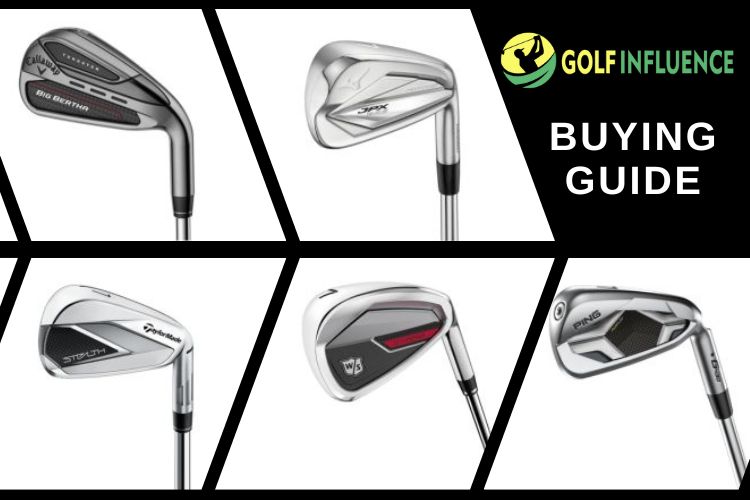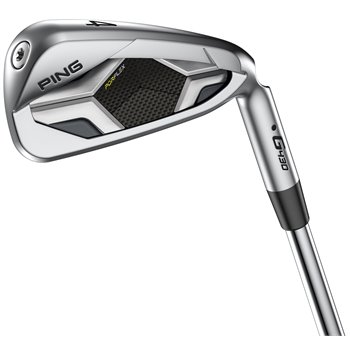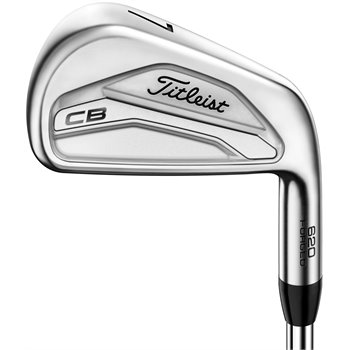Updated January 9, 2025. This article was thoroughly audited by multiple golf experts and coaches for its accuracy. You can read more about our rigorous testing protocol here.
Golfers seeking to enhance their golf game often turn to cavity back irons, also known as cavity backs, due to their superior forgiveness and larger sweet spot for off-center hits.
These golf clubs, designed to improve the game, are suitable for all skill levels, from novices to mid-handicap players and even professionals who favor a more forgiving alternative to traditional blade irons.
The deep cavity design of these irons, sometimes called a forged cavity, contributes to their performance and popularity among golfers, making them a great addition alongside a pitching wedge in their golf bag.
Ready to discover the best cavity back irons? Let’s dive right in!




Featured Recommendations
Last updated on 2025-07-02. The links are affiliate links. Product images are served from Amazon Product Advertising API.
Table of Contents
Best Cavity Back Irons 2025
Mizuno JPX 923 Forged Irons
Best Overall Feel

Check Price on Amazon
Check Price on PGA Tour Superstore
Check Price on GlobalGolf
Specifications
- Loft: 21°-49°
- Lie Angle: 60°-63°
- Shaft Length: 35.25”-38.5”
- Swing Weight: D2, D3, D4
Pros
- Exceptional feel and performance
- Well-rounded for mid-handicap players
Cons
- None right now
I recently had the opportunity to test out the Mizuno JPX 923 Forged Irons, and I must say, they lived up to the hype.
It has an exceptional feel and performance that is truly impressive. It’s a perfect choice for mid-handicap players seeking a traditional look without sacrificing playability.
Its COR-TECH face and compact clubhead design offer a fantastic balance of forgiveness and control. Every shot I made feels crisp and satisfying.
The Mizuno JPX 923 Forged Irons truly stands out in terms of performance. The feel at impact is incredibly solid, and the ball flight is high and penetrating.
Off-center hits still produce adequate distance and accuracy, making these irons an excellent choice for those looking to improve their consistency on the course.
Overall, I highly recommend the Mizuno JPX 923 Forged Irons to any golfer seeking the best overall feel in their iron set. However, the price tag may be a bit steep for some golfers.
TaylorMade Stealth Irons
Best Cavity Back Irons for Consistency

Check Price on Amazon
Check Price on PGA Tour Superstore
Check Price on GlobalGolf
Specifications
- Loft: 18.5°-59°
- Lie Angle: 61.5°-64.5°
- Shaft Length: 35”-39.125”
- Swing Weight: D0, D1
Pros
- Powerful and forgiving
- Excellent distance and consistency
Cons
- Not ideal for players seeking maximum workability
When I first tried the TaylorMade Stealth Irons, I was blown away by their power and forgiveness. These irons are perfect for golfers looking for distance and consistency in their shots.
The SpeedFoam technology and Progressive Inverted Cone Technology deliver impressive ball speed and accuracy, even on off-center hits.
On the course, the TaylorMade Stealth Irons performed admirably. It gave me a high launch angle and towering shots that stop quickly on the greens. It also has a significant increase in distance compared to the previous iron set.
These game improvement irons, including long irons, are an excellent option for players looking to add some extra yards to their game.
The only downside is that they may not be the best choice for golfers seeking maximum workability and shot-shaping capabilities.
Read my full TaylorMade Stealth Irons Review
Callaway Big Bertha 2023 Irons
Most Forgiving Cavity Back Irons

Check Price on Amazon
Check Price on PGA Tour Superstore
Check Price on GlobalGolf
Specifications
- Loft: 18°-56°
- Lie Angle: 60.5°-64°
- Shaft Length: 35”-38.75”
- Swing Weight: D0, D1
Pros
- Improved performance compared to the 2021 model
- Strong contender in the cavity back iron market
Cons
- A bit heavy
The Callaway Big Bertha 2023 Irons offer improved performance compared to the 2021 model, making them a strong contender in the cavity-back iron market.
Featuring a Forged 455 face and Speed Frame technology, these irons promise enhanced distance, forgiveness, and control on the golf course.
I had the opportunity to test the Callaway Big Bertha 2023 Irons and found that they lived up to their reputation. The improved performance was noticeable, with increased distance and forgiveness compared to their predecessors.
While the price tag may be a bit steep for some golfers, the overall performance and advancements in technology make these irons a worthy investment for those looking to upgrade their iron set.
Mizuno JPX 923 Hot Metal Irons
Best Cavity Back Iron for High Launch

Check Price on Amazon
Check Price on PGA Tour Superstore
Check Price on GlobalGolf
Specifications
- Loft: 19°-60°
- Lie Angle: 60°-63°
- Shaft Length: 35.25”-38.5”
Pros
- High launch with optimal spin
- Increased forgiveness
- Improved swing speed
Cons
- Not as workable as forged irons
The Mizuno JPX 923 Hot Metal Irons caught my eye with their promise of a high launch, optimal spin, and increased forgiveness. I was eager to see how these irons would perform on the course, and they did not disappoint.
The COR-TECH face and low, deep center of gravity work together to produce a high-launching ball flight with just the right amount of spin for maximum carry and stopping power.
I was truly impressed with the performance of the Mizuno JPX 923 Hot Metal Irons. They delivered their promise of a high launch, and the forgiveness was a welcome feature for those occasional off-center hits.
While they may not offer the same level of workability as some forged irons, their overall performance and ease of use make them an excellent choice for golfers seeking improved performance in their iron game.
Ping G430 Irons
Best Cavity Back Iron for Distance
Check Price on GlobalGolf
Specifications
- Loft: 19°-41°
- Lie Angle: 60.5°-64.1°
- Shaft Length: 35”-38 7/8”
- Swing Weight: D0, D0.5, D2
Pros
- Blend of distance, forgiveness, and control
- Suitable for a wide range of skill levels
Cons
- Slightly behind in feel and looks compared to some competitors
When finding a solid set of cavity backs, the Ping G430 Irons should definitely be on your radar. These irons offer a blend of distance, forgiveness, and control, making them suitable for various skill levels.
I was eager to see how they would perform on the course, and they didn’t disappoint. The Ping G430 Irons provided a consistent and powerful performance throughout my round. The optimized launch, spin, and forgiveness allowed me to confidently hit various shots.
While they may fall slightly behind in terms of feel and looks compared to some competitors, their overall performance makes them a strong option for golfers seeking a well-rounded set of cavity back irons.
Check my honest Ping G430 Irons Review
Wilson Dynapower Irons
Best Budget Cavity Back Irons

Check Price on Amazon
Check Price on PGA Tour Superstore
Check Price on GlobalGolf
Specifications
- Loft: 18°-53°
- Lie Angle: 60°-64°
- Shaft Length: 35.5”-39”
- Swing Weight: D2
Pros
- Impressive distance and forgiveness
- Excellent value for money
Cons
- May not offer the same level of control as more expensive options
The Wilson Dynapower Irons are a fantastic option for mid to high handicap players looking for impressive distance and forgiveness without breaking the bank.
These irons feature a progressive design and a wide sole for improved turf interaction, making them an excellent value option in the cavity back iron market.
During my round with the Wilson Dynapower Irons, I was pleasantly surprised by their performance. They offered impressive distance and forgiveness, allowing me to hit longer shots with greater consistency.
While they may not offer the same level of control as some more expensive options, their performance and value for money make them a great choice for golfers looking to improve their game without overspending.
Check my full Wilson Dynapower Irons Review
Mizuno JPX 923 Hot Metal Pro Irons
Best for Skilled Players Seeking Forgiveness

Check Price on Amazon
Check Price on PGA Tour Superstore
Check Price on GlobalGolf
Specifications
- Loft: 19°-42.5°
- Lie Angle: 60°-63°
- Shaft Length: 35.5”-38.5”
Pros
- Maximum ball speed and distance
- Forgiving for off-center hits
Cons
- Consistency may not be as strong as other options
The Mizuno JPX 923 Hot Metal Pro Irons offer a unique combination of distance, accuracy, and forgiveness for skilled players looking for a well-rounded option. I was excited to take these irons out on the course and see how they would perform.
The COR-TECH face and advanced design features like the V-Chassis and Deep CG design promise to provide maximum ball speed and distance while still offering forgiveness on off-center hits.
During my round with the Mizuno JPX 923 Hot Metal Pro Irons, I found that they lived up to their promise. The irons offered impressive distance and accuracy, and I was pleasantly surprised by the forgiveness they provided on those less-than-perfect swings.
While consistency may not be their strongest suit compared to other options, the overall performance of these irons makes them a strong contender for skilled players seeking forgiveness in their iron set.
Titleist 620 CB Irons
Best Cavity Backs for Shot Shaping
Check Price on GlobalGolf
Specifications
- Loft: 21°-47°
- Lie Angle: 60°-64°
- Shaft Length: 35.5”-39”
Pros
- Excellent feel and feedback
- Allows for precise shot shaping
Cons
- Not ideal for high handicap players
As a skilled ball striker, I was excited to put the Titleist 620 CB Irons to the test. These irons are designed for players like me who require excellent feel and feedback while allowing for precise shot shaping.
The compact cavity back design and Max Impact technology provide a level of control and playability that is truly remarkable.
During my round with the Titleist 620 CB Irons, I could execute various shots with ease. The irons provided a buttery soft feel at impact and delivered consistent results, even on slight mishits.
However, I wouldn’t recommend these irons for high handicap players, as they may find them a bit less forgiving than other cavity back options. For skilled ball strikers, though, the Titleist 620 CB Irons are a fantastic choice.
Callaway Apex DCB Irons

Check Price on Amazon
Check Price on PGA Tour Superstore
Check Price on GlobalGolf
Specifications
- Loft: 20°-43°
- Lie Angle: 60.5°-64°
- Shaft Length: 35.75”-38.75”
- Swing Weight: D0
Pros
- Wide sole offers outstanding turf interaction
- Oversized head shape provides forgiveness
- Great for high handicap golfers
Cons
- Limited workability, delivers straight shot shape
Great for mid and high handicappers, the Apex DCB offers a nice shape with balanced perimeter weighting and smooth turf interaction. The Callaway irons deliver high launch for your game, helping you from the fairway and from the tee box.
I love how easily the ball launches off the face of the Apex DCB’s and the maximum forgiveness provided no matter where the ball strikes the face.
An easy choice for the best cavity back irons, the Apex DCB features a wide sole to improve your turf interaction to help deliver clean, consistent contact throughout your round.
Read my honest Callaway Apex DCB Irons Review
TaylorMade SIM2 MAX Irons

Check Price on Amazon
Check Price on PGA Tour Superstore
Check Price on GlobalGolf
Specifications
- Loft: 19°-43.5°
- Lie Angle: 61.5°-64.5°
- Shaft Length: 35.75”-39.125”
- Weight: D1
Pros
- Cap-back design delivers power to the ball
- Wider sole improves turf interaction
- High-grade forgiveness redirects off-center strikes
Cons
- Doesn’t offer workability from side to side
The TaylorMade SIM2 MAX Irons offer exceptionally long distance, ideal for mid handicappers hoping to increase their swing speed.
With several of the company’s popular features, such as the Thru-Slot Speed Pocket and Cap-Back Design, the SIM2 MAX irons provide terrific consistency at a low price for a first-rate set.
The set also boosts launch for far-reaching carry that translates into extra yards. Each iron boasts a wide sweet spot, encouraging forgiveness that keeps off-center strikes on target without losing speed.
A wonderfully capable set for mid handicappers, the SIM2 MAX collection provides a solid base for improving your game from the fairway.
Read my full TaylorMade Sim2 Max Irons Review
Callaway Mavrik Irons

Check Price on Amazon
Check Price on PGA Tour Superstore
Check Price on Global Golf
Specifications
- Loft: 18°-41°
- Lie Angle: 60.5°-64°
- Shaft Length: 35.75”-38.875”
- Weight: D1/D3
Pros
- Outstanding impact feel and responsiveness
- Clean turf interaction with powerful energy transfer
- Optimal launch for maximum distance
Cons
- Tighter feel than most cavity-back irons
The Callaway Mavrik Irons are a true winner with exceptional distance and incredible accuracy. The irons come in roughly a dozen different combinations, great for any golfer who likes to mix and match the golf clubs in their bag.
The Mavrik irons are among the best cavity back options on this list. Shaped like forged irons but with the help provided by the shape of cavity back irons, the Mavrik set is incredibly versatile.
Read my honest Callaway Mavrik Irons Review
How to Choose the Best Cavity Back Irons
Design
The design of the top cavity back irons must be inviting to the golfer. No player wants an ugly set of irons, and while that might seem shallow, having confidence in the irons is as important as the club’s overall performance.
When evaluating an iron’s design, golfers need to look at all areas of the club’s head.
Starting with the club’s sole, a golfer needs to notice if the head offers a wide sole that interacts well with the turf to provide clean, crisp contact.
Another aspect of the iron that golfers need to note is the shape of the blade. Is it rounded or angular?
A rounded face helps with forgiveness on shots that strike the toe. An iron that offers a wide hitting area with maximum forgiveness is the best of both worlds.
Flex
Before making the final decision, golfers should know why they need the right flex in their graphite or steel shafts in their irons.
The flex of the shaft on a cavity back iron corresponds with the golfer’s swing speed. Matching the flex of the iron with the player’s swing speed is an absolute must for the golfer to achieve maximum production.
There are three common types of flex for golf clubs; senior, regular, and stiff. These categories typically fit with a swing speed. For example, a stiff flex is needed for golfers who swing their driver over 95 mph.
Golfers can greatly affect their results by choosing the wrong flex or not understanding how a type of shaft affects shotmaking.
Materials
When evaluating the iron’s materials, golfers need to look at all areas of the club’s head to see how designers constructed the head, shaft, and grip.
Most heads are a combination of carbon steel, composite materials, and weighting that anchors the iron and deepens the center of gravity.
Since the head is the most important element of a cavity back iron, players should also look at how the carbon steel sole, leading edge, and top line profile the face’s overall look.
The best cavity back irons offer first-rate performance alongside exceptional design and construction, but that all falls apart if the iron’s materials are subpar.
Low price irons will use lower-quality materials, which could affect performance, while higher-end irons utilize premium materials for a lighter yet stronger experience.
Shafts
Golfers can choose either a graphite shaft or a stainless steel shaft for their cavity back iron. Both shafts offer benefits, although players typically make a fatal mistake when choosing between them.
Graphite shafts are lighter, making them the perfect choice for senior golfers who need more swing speed. However, some experienced players don’t like the flexible nature of a graphite shaft, preferring the sturdiness of a stainless steel shaft.
But those weekend warriors might not need the swing speed benefit that graphite provides players with slower swings.
Steel shafts offer a heavier feel, but that is also a comfort to players who want less flex during their swings with their irons.
Price
A quality set of cavity back irons costs around $500 and tops out at $1500 for luxury models.
Most golf equipment manufacturers create iron sets that offer premium performance with value to their wallet.
While value sets may skimp in a few areas concerning design, these lower-end club sets offer a lower price coupled with heel and toe balance, minimal offset, and a lower center of gravity while elevating swing speeds.
Golfers can expect to find features such as a wide, inviting hitting area, innovative technology that boosts distance, and a higher launch that offers extended carry in top cavity back irons.
While price is always a consideration for players, they must weigh the benefits of the new set against its cost before making their final decision.
Frequently Asked Questions

What are cavity-back irons?
Cavity-back irons have a distinct shape and appearance compared to forged irons, which are also commonly referred to as blade irons.
When looking at the iron head, the back of the head looks like the material has been scooped out, creating a “cavity” behind the face. The reasoning for creating an iron with this style benefits the beginning golfer as the iron becomes lighter through the loss of material.
Another reason the cavity-back works well for inexperienced golfers is that designers balance the outer rim of the iron, helping keep the face square through the impact zone.
The cavity-back design also allows designers to create a large, wide sole that boosts launch. By adding additional material along the sole of the club, golfers get a deeper center of gravity to smoothly lift the ball at impact.
Not all cavity-back irons are built the same and some of these irons from lesser manufacturers can be quite heavier than other brands. Golfers should understand how weight affects swing speed which in turn manipulates the distance of shots.
That said, if you are a high handicapper or beginning golfer, the best choice for starting or improving the quality of your golf shots from the fairway and intermediate rough is with cavity-back irons.

What’s the difference between cast and forged cavity back irons?
Cast cavity back irons are typically found in game improvement irons that most amateur golfers play. These irons offer better balance, perimeter weighting, and forgiveness to give inexperienced players better consistency with each shot.
Cast cavity back irons help the golfer easily get the golf ball into the air for extended carry and maximum distance.
Forged irons are crafted from one piece of metal and made especially for advanced golfers who want clubs that offer premium workability.
They are designed to offer a compact hitting area that provides control for low handicappers who can hit shots of various shapes and heights.
With routine maintenance, golf irons can last several years. Periodic cleaning of the face and grooves can provide optimum spin and clean contact.
The number one way that players can improve their set of irons is by replacing the grips every 40 rounds or two years. Grips can harden and become slick, causing the golfer to lose confidence in their ability to hold the club.
Carbon steel golf irons can become brittle and rusted if the golfer soaks the head and shaft in water for hours at a time. The glue that binds the shaft and shaft can weaken, causing the iron to fall apart.

Do any pros play cavity backs?
Yes, 44% of the top 50 tour players in strokes gained play cavity back irons, showing that pros indeed play them. Cavity backs are a popular choice among professional golfers.

What is the main advantage of cavity back irons?
Cavity back irons offer improved forgiveness and a larger sweet spot, making them easier to hit and more consistent for players of all levels.
Recommended: Blades vs Cavity Back Irons: What’s the Difference?



